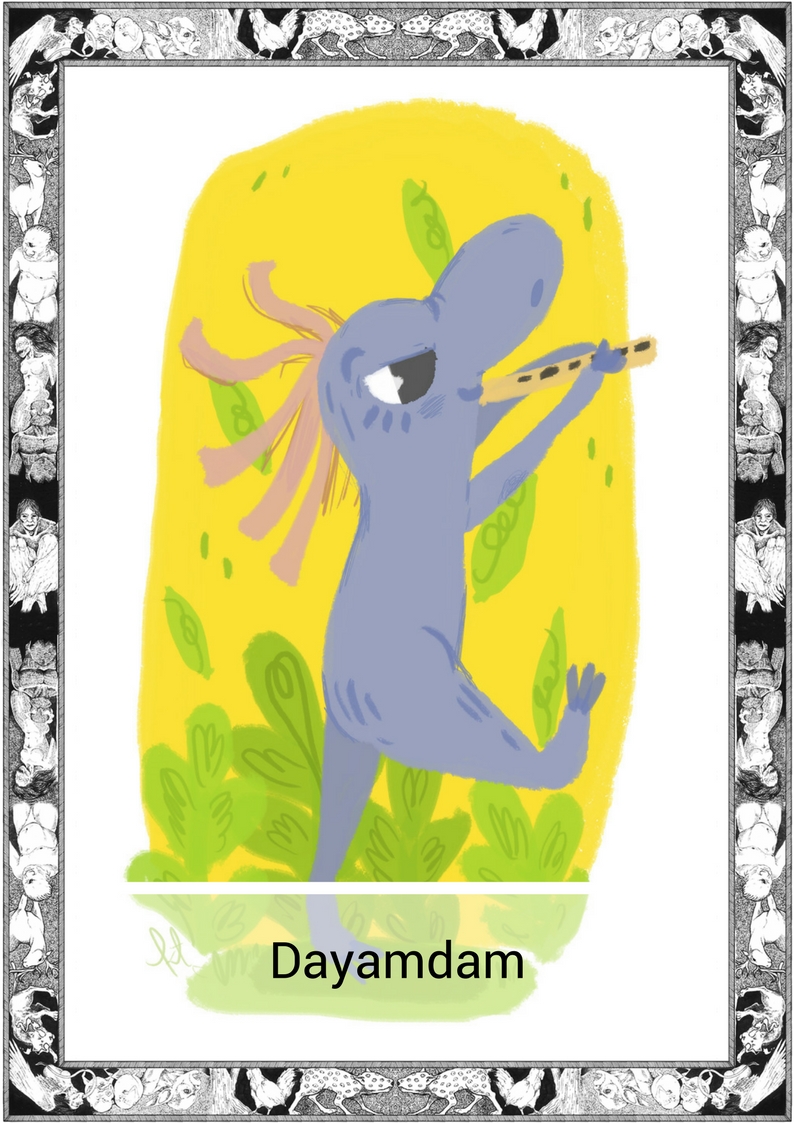
*Note this story is in Cebuano
“Busa suginli ko kabahin sa imong kahoy,” miingon ang buyog sa Dayamdam.
“Buyno, kini ang labing maayo nga kahoy sa kalibutan alangan!” Magarbohon nga mitubag ang Dayamdam. Nasayod ang kadagdahan nga walay kahoy sa kalasangan ang mutombas sa katahom ni’ng kahoya. Aduna kini’y nindot nga mga bulak nga namulak sa ting-init ug kung mamunga! Pagkatam-is ug baho nga labing makapalipay nga butang sa bisan kinsang nakapanimaho.
Nangutana ang buyog, “Unsa sa mga tawu? Gipakigbahin ba nila imong mga hunahuna sa kahoy?”
“Nahibalo naka kung unsa ang mga tawu,” and Dayamdam mitubag. Kanunay naghuna-huna sa kaugalingon. Dili man galing mangayo ug pagtugot kung manguha ug bunga sa akong kahoy.”
“Pagkadinul-anan!” Misinggit ang buyog.
“Kining mga tawu walay pamatasan” sa mapagmahitas-ong tubag sa Dayamdam.
Niadtong panahona, ang tibuok nga kahoy miuyog. Ang buyog milupad paingun sa luwas nga dapit, apan ang Dayamdam nagpabilin sa mga sanga sa kahoy.
“Kinahanglan kang mudagan!” singgit sa buyog.
“Unsa’y nahitabo?!” pagtuaw sa Dayamdam.
“Ang mga tawu! Ang mga tawu giputol imong kahoy.” Misuway pagtabang ang buyog sa Dayamdam apan gamay kaayo kini aron mubitbit sa linalang. Padayon gihapon ang buyog sa pagtabang sa iyahang higala pinaagi sa pag-ikos sa mga tawu kinsa misuway pagputol sa kahoy, apan walay kapuslanan.
“Dagan higala! Dagan palayo!” ang buyog misinggit.
“Apan nasayod ang buyog nga dili mubiya ang iyahang higala sa kahoy. Alang sa Dayamdam, ang kahoy labaw pa sa usa ka puluy-anan. Ang kahoy sa kinatibuk-an niini nga misanga sa mga ugat ug mga buwak sa kasingkasing niini. Mamahimong makabuhat ug mga sinina gikan sa mga dahon sa kahoy ug mogahin sa tibuok niyang kinabuhi sa taliwala sa panit ug sa bunga.
Ang buyog mitutok samtang ang kahoy giputol sa mga kamot sa tawo ug kung mahimo pa kini muhilak, hagbay ra kini mihilak alang sa iyahang higala. Ang mga tawu miangkon ug labaw pa sa usa ka biktima matag-adlaw, ug ang tibuok kalasangan giila kini.
Niadtong gabhiuna ang mga kahoy naglanog-lanog sa mga awit sa Dayamdam, sa walay katapusan nga paghinumdom sa labing matahum nga kahoy sa lasang.
English Version
“So tell me about your tree,” said the bee to the dayamdam.
“Well, it’s the best tree in the world of course!” The dayamdam said proudly. It had known that no other tree in the forest could match the beauty of its tree. It had beautiful flowers that bloomed in the summer and when it bore fruit! Oh was the sweet smell the most ravishing thing any being had ever smelled.
The bee asked “What of the humans? Do they share your thoughts on the tree?”
“You know how humans are,” the dayamdam replied. “Always thinking of themselves. They don’t even ask for permission when gathering fruit from my tree.”
“How rude!” the bee exclaimed.
“These humans don’t have any manners” the dayamdam said haughtily.
Just then, the entire tree shook. The bee flew away to safety, but the dayamdam stayed in the branches of its tree.
“You must run away!” The bee shouted
“What is happening?!” The dayamdam cried out.
“The humans! The humans are cutting your tree.” The bee tried to help the dayamdam but it was too small to carry the creature. The bee still tried to help its friend by stinging the humans as they tried to cut the tree down, but to no avail.
“Run my friend! Run far away!” The bee exclaimed again.
But the bee knew that its friend would never leave the tree. For the dayamdam, the tree was more than just a simple home. The tree was its entire life the branches its veins and the flowers its heart. It would make clothes from the tree’s leaves and spend the entirety of its lifetime in between the bark and the fruit.
The bee stared as the tree was felled by human hands and if it could cry it would shed a tear for its fallen friend. The humans claimed more than one victim that day, and the whole forest would acknowledge that.
That night the trees echoed with the songs of the dayamdam, forever remembering the most beautiful tree in the forest.
————————–————————–——————–
*The Cebuano language, alternatively called Cebuan and also often colloquially albeit informally referred to by most of its speakers simply as Bisaya (“Visayan”, not to be confused with other Visayan languages nor Brunei Bisaya language), is an Austronesian regional language spoken in the Philippines by about 21 million people, mostly in Central Visayas, western parts of Eastern Visayas and most parts of Mindanao, most of whom belong to various Visayan ethnolingusitic groups, mainly the Cebuanos. It is the by far the most widely spoken of the Visayan languages, which are in turn part of wider the Philippine languages. The reference to the language as Bisaya is not encouraged anymore by linguists due to the many languages within the Visayan language group that may be confused with the term. The Komisyon ng Wikang Filipino, the official regulating body of Philippine languages, spells the name of the language as Sebwano.
Written by Karl Gaverza
Cebuano Translation by Dominic G. Quilantang
Copyright © Karl Gaverza
Translation Copyright © Dominic G. Quilantang
Inspired by the Dayamdam description in Myth Museum. Medina. 2015.
Dayamdam Illustration by Kayla Teodoro
Tumblr: mikaylateodoro.tumblr.com
